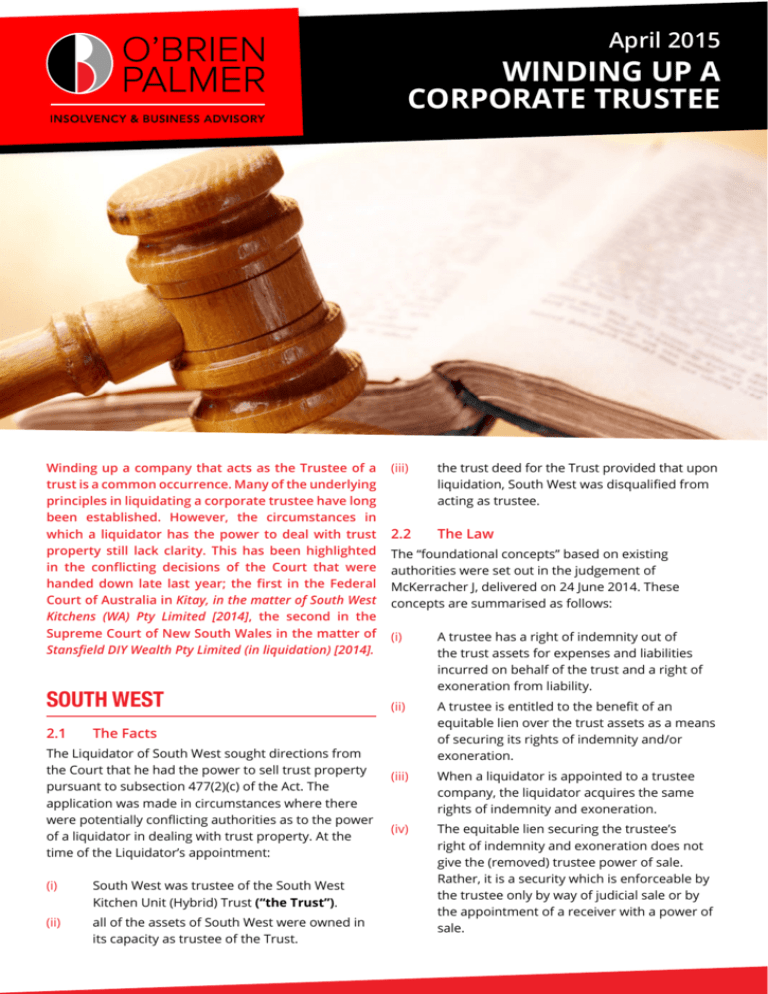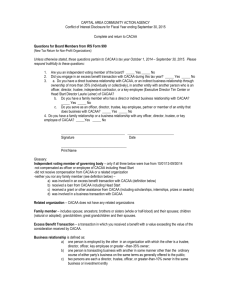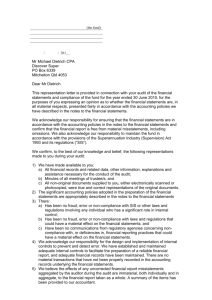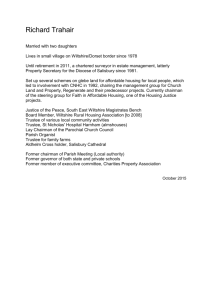WINDING UP A CORPORATE TRUSTEE
advertisement

April 2015 WINDING UP A CORPORATE TRUSTEE Winding up a company that acts as the Trustee of a trust is a common occurrence. Many of the underlying principles in liquidating a corporate trustee have long been established. However, the circumstances in which a liquidator has the power to deal with trust property still lack clarity. This has been highlighted in the conflicting decisions of the Court that were handed down late last year; the first in the Federal Court of Australia in Kitay, in the matter of South West Kitchens (WA) Pty Limited [2014], the second in the Supreme Court of New South Wales in the matter of Stansfield DIY Wealth Pty Limited (in liquidation) [2014]. SOUTH WEST 2.1 The Facts The Liquidator of South West sought directions from the Court that he had the power to sell trust property pursuant to subsection 477(2)(c) of the Act. The application was made in circumstances where there were potentially conflicting authorities as to the power of a liquidator in dealing with trust property. At the time of the Liquidator’s appointment: (i) South West was trustee of the South West Kitchen Unit (Hybrid) Trust (“the Trust”). (ii) all of the assets of South West were owned in its capacity as trustee of the Trust. (iii) the trust deed for the Trust provided that upon liquidation, South West was disqualified from acting as trustee. 2.2 The Law The “foundational concepts” based on existing authorities were set out in the judgement of McKerracher J, delivered on 24 June 2014. These concepts are summarised as follows: (i) A trustee has a right of indemnity out of the trust assets for expenses and liabilities incurred on behalf of the trust and a right of exoneration from liability. (ii) A trustee is entitled to the benefit of an equitable lien over the trust assets as a means of securing its rights of indemnity and/or exoneration. (iii) When a liquidator is appointed to a trustee company, the liquidator acquires the same rights of indemnity and exoneration. (iv) The equitable lien securing the trustee’s right of indemnity and exoneration does not give the (removed) trustee power of sale. Rather, it is a security which is enforceable by the trustee only by way of judicial sale or by the appointment of a receiver with a power of sale. Forward to a Friend | opb.com.au | Unsubscribe April 2015 WINDING UP A CORPORATE TRUSTEE According to his Honour, the issue arising beyond these concepts and on which there may be some doubt in the authorities, is whether the liquidator of a trustee company that is unable to continue acting as trustee: (a) can exercise the power of sale granted to liquidators pursuant to subsection 477(2)(c) of the Act; (b) is required in each instance to obtain a court order to sell trust assets. His Honour expressed the view that the operation of subsection 477(2)(c) in these circumstances had not been expressly considered in previous judgements, except in the decision of Finkelstein J in Apostolou v VA Corporation AUST Pty Ltd (2010) 77 ACSR 84 (“Apostolou”). In that case, his Honour found that the Liquidator had a dual power to realise trust assets in the course of winding up a company which acted as trustee, where the company has both legal title and an equitable interest in the trust assets; that power being conferred pursuant to the trust deed and also pursuant to subsection 477(2)(c) of the Act. 2.3 The Decision In delivering his judgement, his Honour followed the decision in Apostolou, finding that: (i) South West had both legal ownership of the assets of the Trust as a bare trustee and beneficial interest in the assets as a holder of an equitable lien. (ii) there is no reason in policy or principle and none referred to in the authorities discussed, as to the why a liquidator’s powers of sale should be limited by the terms of a private trust agreement. other reason why a liquidator ought not be permitted in a straightforward case to discharge his or her duties to conduct the liquidation in the ordinary manner. (v) proceeding this way makes good practical sense avoiding the need for liquidators of trustee companies to approach the Court on every occasion to seek approval to sell trust assets Accordingly, his Honour declared that the Liquidator had power pursuant to subsection 477(2)(c) of the Act to sell, dispose or otherwise deal with the assets of the Trust. STANSFIELD 3.1 The Facts The Liquidator of Stansfield sought directions from the Court to the effect that the company in liquidation be permitted to sell or otherwise deal with the property of a superannuation fund. This application was no doubt filed in light of the potentially conflicting authorities but with the added complication that the property in question was held on account of a superannuation fund. At the time of the Liquidator’s appointment; (i) Stansfield was acting as trustee of the Elliot Stansfield Super Fund, a regulated self- managed superannuation fund (“the Fund”). (ii) the assets of the Fund totalled $108,916. (iii) the liabilities of the Fund totalled $98,941. (iv) the only function of Stansfield was to act as trustee of the Fund. 3.2 The Law (iii) In his judgement delivered on 30 October 2014, Brereton J said that there were two relevant potential there appears to be no constraint on the scenarios; the first that the company in liquidation power of sale under subsection 477(2)(c) of the remained as trustee of the Fund and the second, the Act, nor does it impose any limitation on the company in liquidation does not remain as trustee of power of sale insofar as the assets of a the Fund. company held on trust. (iv) in the absence of any statutory constraint or other complication, there appears to be no 2 April 2015 WINDING UP A CORPORATE TRUSTEE 3.2.1 The company in liquidation remaining as trustee of the Fund In relation to the first scenario, his Honour concluded that so long as the company in liquidation remained as trustee of the Fund, then the Liquidator was entitled (subject to the impact of superannuation laws) to administer the assets of the Fund, pay the creditors of the Fund, wind up the Fund and recover all of his remuneration and expenses from the assets of the Fund. 3.2.2 The company in liquidation not remaining as trustee of the Fund In relation to the second scenario, his Honour essentially agreed with the foundational concepts set out in South West which are summarised above. His Honour then when on to consider the possible application of subsection 477(2)(c) of the Act in light of the relevant case law and particular, the judgements delivered in Apostolou and South West. The conclusion reached by his Honour was that he respectfully disagreed with the decision in Apostolou, finding instead that subsection 477(2)(c) does not empower a liquidator to sell the beneficial interest in property that a company holds on trust even if the company holds an equitable charge over that property because the property is not itself “property of the company”. To put that another way, a liquidator’s power to deal with property does not extend to property that is not beneficially the property of the company. 3.2.3 The impact of Superannuation Law His Honour was obliged to also consider the operation of the Superannuation Industry (Supervision) Act 1993 (“SISA”) concluding that a company in liquidation becomes a “disqualified person” for the purposes of that legislation but notwithstanding, remains as trustee of the Fund. However, by continuing to be and act as trustee, a company contravenes section 126K of SISA and thereby commits an offence. If, as would be prudent, a company resigned as trustee once a liquidator has been appointed to it, then the liquidator would have no power of sale. 3.3 The Decision In light of the foregoing, his Honour declined to make the direction sought by the Liquidator. Rather, his Honour proposed to make declarations and orders pursuant to subsection 479(3) of the Act to the following effect: (i) The Liquidator would be justified in causing the company to resign as trustee of the Fund. (ii) The Liquidator would be justified in applying to the Court to be appointed as receiver without security of the assets of the Fund with the powersthat a liquidator has in respect of the property of a company under subsection 477(2)(c)of the Act. CONCLUSION It is obvious from these judgements that the law is not settled in relation to dealing with trust property in circumstances where the trustee company has been wound up and is no longer acting in that capacity. The decision in South West is commercially sensible and avoids the need for a liquidator of a trustee company to approach the Court on every occasion trust property is to be sold. This of course conflicts with the judgement in Stansfield. This conflict needs to be resolved either by the legislature or the High Court. In the meantime, a liquidator appointed to a trustee company will be subject to the law of trusts in the particular State in which he or she practises and will need to seek legal advice as to the appropriate way to deal with trust assets. The partners of O’Brien Palmer are presently minded to follow the process in Stansfield until such time as they are advised otherwise. 3 OUR SERVICES Corporate Insolvency Personal Insolvency Other Services • • • • • • • • • • • • • • • • • • • Voluntary Administration Deeds of Company Arrangement Receiverships Court Liquidation Members’ Voluntary Liquidations Creditors’ Voluntary Liquidations Provisional Liquidations Official Liquidations • Bankruptcy Part X Personal Insolvency Agreements Trustee appointments pursuant to Section 66G of the Conveyancing Act Part XI Deceased Estate Administration Business Recovery Business Viability Reviews Prelending/Refinancing Reviews Security Reviews Management Reporting Cash-Flow Management Turnaround and Growth Strategies Without obligation or cost, we are available for an initial consultation. Please contact: Chris Palmer Bryan Collis Liam Bailey Andrew Cowled cpalmer@obp.com.au bcollis@obp.com.au lbailey@obp.com.au acowled@obp.com.au SYDNEY Level 14, 9 Hunter Street, Sydney NSW 2000 | GPO Box 3385, Sydney NSW 2001 Telephone +61 2 9232 3322 | Facsimile +61 2 9232 3388 BATHURST 103 Piper Street, Bathurst NSW 2795 | PO Box 2153, Bathurst NSW 2795 Telephone +61 2 6338 2650 | Facsimile +61 2 9232 3388 This information memorandum is of necessity general in nature and its brevity could lead to misinterpretation and misunderstanding. No responsibility can be accepted for those who act on its contents without first consulting us and obtaining specific advice. Copyright © 2015 O’Brien Palmer Liability limited by a scheme approved under Professional Standards Legislation.







